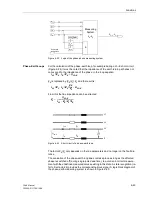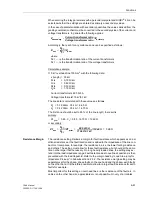
Functions
6-56
7SA6 Manual
C53000-G1176-C156-2
Figure 6-29
Polygonal characteristic
Direction
Determination
For each loop an impedance vector is also used to determine the direction of the short-
circuit. Usually similar to the distance calculation, Z
L
is used. However, depending on
the “quality” of the measured values, different computation techniques are used. Im-
mediately after fault inception, the short circuit voltage is disturbed by transients. The
voltage memorized prior to fault inception is therefore used in this situation. If the
steady-state short-circuit voltage (during a close-in fault) is even too small for direction
determination, an unfaulted voltage is used. This voltage is in theory quadrilateral to
the actual short-circuit voltage for both phase–earth loops as well as for phase–phase
loops (refer to Figure 6-30). This is taken into account when computing the direction
vector by means of a 90°–rotation. In Table 6-9 the allocation of the measured values
to the six fault loops for the determination of the fault direction is shown.
Forwa
rd
α
ϕ
R
e
ve
rs
e
Reve
rse
F
o
rw
a
rd
Line Characteristic
Load Area
Load Area
R
X
Z5
Z4
Z2
Z1B
Z3
Z1
Summary of Contents for siprotec 7SA6
Page 2: ...Siemens Aktiengesellschaft Book No C53000 G1176 C156 2 ...
Page 18: ...xviii 7SA6 Manual C53000 G1176 C156 2 ...
Page 32: ...Introduction 1 14 7SA6 Manual C53000 G1176 C156 2 ...
Page 82: ...Hardware and Connections 2 50 7SA6 Manual C53000 G1176 C156 2 ...
Page 119: ...SIPROTEC 4 Devices 4 25 7SA6 Manual C53000 G1176 C156 2 Figure 4 20 CFC Logic example ...
Page 190: ...Configuration 5 62 7SA6 Manual C53000 G1176 C156 2 ...
Page 652: ...Installation and Commissioning 8 78 7SA6 Manual C53000 G1176 C156 2 ...
Page 724: ...Technical Data 10 56 7SA6 Manual C53000 G1176 C156 ...
Page 800: ...Appendix A 76 7SA6 Manual C53000 G1176 C156 2 ...
Page 866: ...Appendix B 66 7SA6 Manual C53000 G1176 C156 2 ...
















































